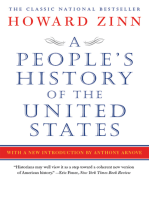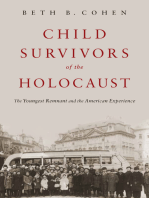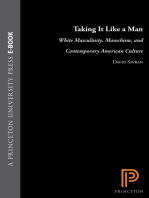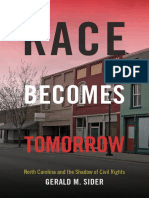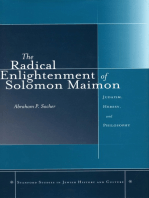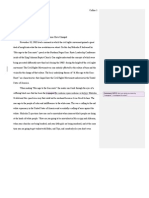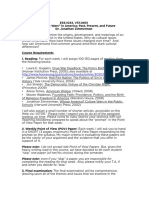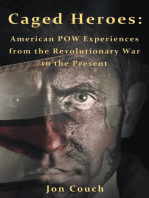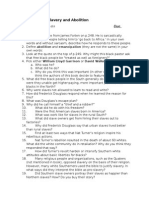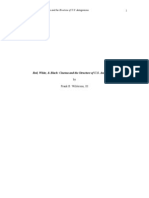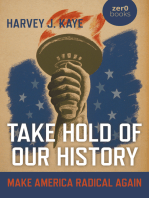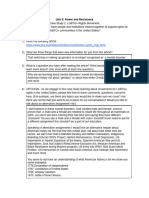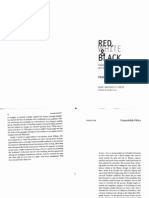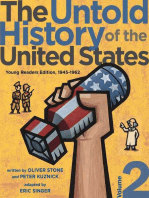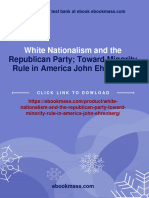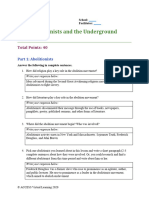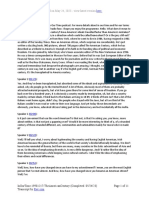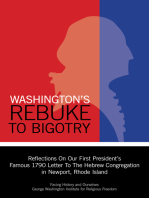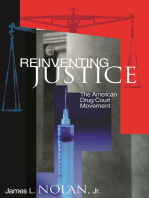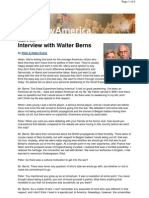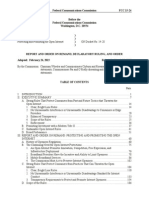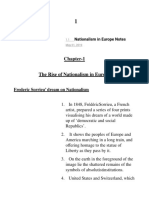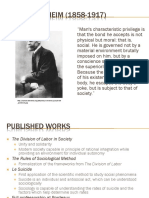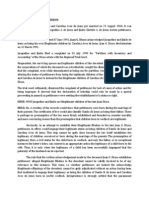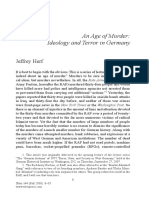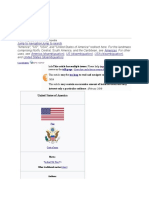0 ratings0% found this document useful (0 votes)
143 viewsTeachingvoices ch09
Teachingvoices ch09
Uploaded by
Joe BradleyTo be used in conjunction with "A People's History of the United States."
Copyright:
Attribution Non-Commercial (BY-NC)
Available Formats
Download as PDF, TXT or read online from Scribd
Teachingvoices ch09
Teachingvoices ch09
Uploaded by
Joe Bradley0 ratings0% found this document useful (0 votes)
143 views17 pagesTo be used in conjunction with "A People's History of the United States."
Original Title
teachingvoices_ch09
Copyright
© Attribution Non-Commercial (BY-NC)
Available Formats
PDF, TXT or read online from Scribd
Share this document
Did you find this document useful?
Is this content inappropriate?
To be used in conjunction with "A People's History of the United States."
Copyright:
Attribution Non-Commercial (BY-NC)
Available Formats
Download as PDF, TXT or read online from Scribd
Download as pdf or txt
0 ratings0% found this document useful (0 votes)
143 views17 pagesTeachingvoices ch09
Teachingvoices ch09
Uploaded by
Joe BradleyTo be used in conjunction with "A People's History of the United States."
Copyright:
Attribution Non-Commercial (BY-NC)
Available Formats
Download as PDF, TXT or read online from Scribd
Download as pdf or txt
You are on page 1of 17
Voices of a Peoples History
of the United States
TEACHERS GUIDE
Gayle Olson-Raymer
Humboldt State University
With selected chapters written by Humboldt County AP Teachers:
Jack Bareilles (McKinleyville High School), Natalia Boettcher (South
Fork High School), Mike Benbow(Fortuna High School), Ron Perry
(Eureka High School), Robin Pickering, Jennifer Rosebrook (Arcata
High School), Colby Smart (Ferndale High School), and Robert
Standish (South Fork High School)
SEVEN STORIES PRESS
New York Toronto London Melbourne
Teachers Guide 20050202:Layout 1 7/29/08 8:49 AM Page 3
Copyright :cc, by Gayle Olson-Raymer
All rights reserved. No part of this book may be reproduced, stored in a retrieval
system, or transmitted in any form, by any means, including mechanical, digital,
photocopying, recording, or otherwise, without the prior written permission of the
publisher.
Seven Stories Press
:c Watts Street
New York, NY :cc:,
www.sevenstories.com
ISBN-:c: :-,,::-o,- / ISBN-:,: ,;-:-,,::-o,-
College professors may order examination copies of all Seven Stories Press titles for
a free six-month trial period. To order, visit www.sevenstories.com/textbook, or fax
on school letterhead to :::-::o-;oc.
College professors who have adopted Voices of a Peoples History of the United States
by Howard Zinn and Anthony Arnove as a course textbook are authorized to
duplicate portions of this guide for their students.
Design by Jon Gilbert
Printed in the U.S.A.
Teachers Guide 20050202:Layout 1 7/29/08 8:49 AM Page 4
~ :c, ~
CHAPTER NINE
Slavery and Defiance
In the PBS documentary Africans in America, historian Margaret Washington says,
In some ways, when you enslave a person, you enslave yourself. If everyone in
pre-Civil War society was victimized by slavery, it should come as no surprise that
some Americans, both black and white, resisted the peculiar institution. Yet these
stories of resistance are largely omitted from traditional classroom discussions
about slavery in pre-Civil War America.
When resistance is examined in many classroom settings, all too often it is from
the perspective of the white abolitioniststhose who supported Frederick
Douglass and made the Underground Railroad a reality. The voices and actions of
ordinary free and enslaved African Americans who defied the systemwho risked
their lives for freedomare rarely included in traditional classroom analyses of
slavery. How can their voices be silenced? students ask. Why have I never heard
of Nat Turner before this class? These are good questions. Students usually deter-
mine that the fear engendered in many Americans tells them that if we learn about
and celebrate defiance of the law, and if we question the actions of our historical
leaders who made the laws, we are being unpatriotic. Yet, in the spirit of revolu-
tionary America, what could be more patriotic than fighting for freedom?
Document-Based Questions
DAVID WALKERS APPEAL
:. What parts of this appeal do you think were especially inflammatory to
Southern slaveholders? Explain.
:. Do you think Walker makes an effective argument in regard to the
hypocrisy in the language and promises of the Declaration of
Independence? Explain.
,. If you had lived in :,c when this appeal was published, how would you
Teachers Guide 20050202:Layout 1 7/29/08 8:50 AM Page 109
have answered Walkers question, Now, Americans! I ask you candidly,
was your sufferings under Great Britain, one hundredth part as cruel and
tyrannical as you have rendered ours under you?
HARRIET A. JACOBS AND JAMES NORCOM
:. What was Nat Turners insurrection? How and why did it affect Harriet
Jacobs life and the lives of other slaves throughout the south?
:. What was the goal of the Reverend Pikes message to his enslaved congre-
gation? What is your response to this message?
,. Why were Jacobs and her friends amused at brother Pikes gospel teach-
ing? What are the moral and ethical implications of a ministers endorse-
ment of slavery?
. How would you respond to James Norcoms statement that Jacobs
absconded from the plantation of my son without any known cause or
provocation? Do you think it is possible that slaveholders truly believed that
there were not reasons for the enslaved to run away? Explain.
JAMES R. BRADLEY
:. How does James Bradley feel about being owned by someone who was
called a wonderfully kind master? How do you think the southern states
were able to convince people in the so-called free states that the enslaved
were happy and contented?
:. Do you agree with Bradley that there was never a slave who did not long
for liberty? Explain.
,. What does Bradleys letter tell you about the relationship between white and
black people in pre-Civil War society?
REVEREND THEODORE PARKER
:. What are Reverend Parkers main objections to the Fugitive Slave Act? How
does he think its passage has changed the manner in which the
Constitution was interpreted?
::c ~ cuairii xi xi
Teachers Guide 20050202:Layout 1 7/29/08 8:50 AM Page 110
:. What did the Reverend Parker mean when he claimed that the Bostonians
were subjects of Virginia? How does this support the idea of a slave
power in the South that determines the law for the rest of the nation? Do
you think slave power existed? Explain.
,. What does Parker describe as deeds done for liberty? Do you agree with
his statement that when liberty is the end . . . sometimes peace is not the
means towards it? Explain. What kinds of deeds for liberty might be
used in todays society? Do you think the Founding Fathers would approve
of such deeds?
TWO LETTERS FROM SLAVES
:. By legally defining the enslaved as property, how were slave owners able to
justify enslavement?
:. What common complaints do these formerly enslaved men share in regard
to their masters? Do you think Henry Bibb would agree with Jermain Wesley
Loguen that he pities his former master fromthe bottomof my heart? How
do their feelings about their former masters compare and contrast?
,. Do you think that slave masters truly believed that they raised their slaves
as we did our own children? Explain.
FREDERICK DOUGLASS
:. What are Douglasss objections to celebrating the Fourth of July? What did
he mean when he said, Your high independence only reveals the immeas-
urable distance between us?
:. How do you think the Rochester Ladies Anti-Slavery Society responded
to Douglasss speech? What do you think would especially resonate with
them? To what parts of the speech do you think they may have objected?
Explain.
,. Do you agree or disagree with Douglasss statement that [t]here is not a
nation on the earth guilty of practices more shocking and bloody than are
the people of the United States, at this very hour? Explain. What other injus-
tices were going on in the United States in :,: that could further justify
Douglasss statement?
siavii\ axo oiii axci ~ :::
Teachers Guide 20050202:Layout 1 7/29/08 8:50 AM Page 111
JOHN BROWNS LAST SPEECH
:. Why do you think large numbers of black and white people did not join
in John Browns struggle?
:. In :,,, most Americans thought that John Brown was a treasonous mur-
derer. Why do you believe such famous Americans as Henry David
Thoreau, Ralph Waldo Emerson, and Frederick Douglass thought John
Brown was a hero?
,. How does John Brown try to justify his actions? Do you think he is con-
vincing? Why, or why not? What did his death accomplish?
OSBORNE P. ANDERSON
:. What is the purpose of Osborne Andersons statement about John Browns
raid on Harpers Ferry? Do you think he accomplished his purpose?
:. What do you think accounted for Andersons observation that the free
blacks [of the] South are much less reliable than the slaves, and infinitely
more fearful?
,. Did Andersons prediction come truethat the future historian will
record that John Browns mistakes at Harpers Ferry were productive of
great good? How have historians dealt with Harpers Ferry and John
Brown?
MARTIN DELANYS ADVICE
:. Delany describes the passive resistance he would have used had he been a
slave. What is passive resistance? How does he describe it? How do other
voices in this chapter describe their use of passive resistance? Howdid slave-
holders interpret acts of passive resistance?
:. What advice does Delany offer the freedmen and women? What is it that
he most fears that freedmen and freedwomen will do?
,. Who does Delany most mistrust? How and why?
::: ~ cuairii xi xi
Teachers Guide 20050202:Layout 1 7/29/08 8:50 AM Page 112
HENRY MCNEAL TURNER
:. For what crime is Turner being tried? What rights does Turner demand
before the Georgia legislature? Do you think his arguments are convincing?
How and why do you think his fellow legislators decided as they did?
:. Three years after the end of the Civil War, the Georgia legislature had been
reconstructedyet it found Turner guilty of the crime of being black
and forced Turner to conclude that freedmen and freedwomen were
strangers in the land of our birth. What does this attitude tell you about
the success and failure of reconstruction in Georgia?
,. To what constitutional rights were the freedmen and freedwomen entitled?
Why was the state of Georgia able to ignore these rights?
Main Points in Voices, Chapter 9, Slavery and Defiance
After reading Chapter , in Voices, students should be encouraged to identify what
they believe to be the main points therein. Following are five possible main points.
:. Enslaved African Americans resisted slavery from the moment it was insti-
tutionalized into colonial law until it was constitutionally prohibited by
the Thirteenth Amendment.
:. The political, economic, and religious nature of southern society, all rein-
forced the belief that slavery was a benevolent institution as well as one
that was endorsed by God.
,. The federal government not only failed to challenge the system of institu-
tionalized slavery created by each Southern state; it also legitimized the sys-
tem through passage and enforcement of the Fugitive Slave Act.
. The abolitionist movement consisted of whites and free blacks, all of whom
challenged and sometimes defied the laws upholding slavery.
,. While the Thirteenth, Fourteenth, and Fifteenth Amendments promised
previously enslaved African Americans their freedom and equality, that
promise was negated by the end of Reconstruction.
siavii\ axo oiii axci ~ ::,
Teachers Guide 20050202:Layout 1 7/29/08 8:50 AM Page 113
Main Points in Voices, Chapter 9, Slavery and Defiance, and
in A Peoples History, Chapter 9, Slavery Without Submission,
Emancipation Without Freedom
If your students are also reading A Peoples History, they should be encouraged to
identify what they believe to be the main points in Chapter , in both books.
Following are four additional points to be stressed when Voices and A Peoples
History are used together.
o. The events before, during, and after the Civil War continue to shape race
relations in the United States today.
;. The Emancipation Proclamation declared slaves in the Confederate states
still fighting against the Union to be free but failed to free slaves living
behind Union lines.
. The end of institutionalized slavery led to a reconstruction of national pol-
itics and economics that was both safe and profitable for the Northern and
Southern elite who supported the war.
,. Lincoln signed the Emancipation Proclamation only when many of his
supporters began to act against slavery.
General-Discussion Questions for Voices
While the following questions are designed for classroom discussion about all the
voices read in Chapter ,, they can also be rewritten and included as evaluation
tools.
:. What common experiences are recorded in the voices of the enslaved? Do
you think all slaves had similar experiences? Explain.
:. Why do you think there were few voices of resistance to slavery among
poor southern whitesmost of whom had no slaves? Why do you think
more poor southern whites did not unite with blacks to attack the planta-
tion system?
,. How were some slaves able to buy their own freedom and/or the freedom
of their family members?
:: ~ cuairii xi xi
Teachers Guide 20050202:Layout 1 7/29/08 8:50 AM Page 114
. What does liberty mean to the people whose voices you heard? Do you
think liberty meant the same thing to white Americans as it did to the
enslaved African Americans? To poor white Americans versus wealthy white
Americans? What does liberty mean to? Would you be willing to fight for
your liberty? Under what circumstances?
,. What was the Freedmans Bureau? How did it help the newly emancipated
African Americans? Did it achieve as much as its creators hoped it would?
Explain.
o. Many historians of this period have concluded that the agricultural and
industrial foundations of the United States were built largely on the backs
of enslaved African Americans. How do the voices in this chapter support
or refute this allegation? What is your opinion? Explain.
;. How did the voices in this chapter reinforce any of the five themes listed
in Main Points in Voices?
. Which of the voices in this chapter did you find most powerful? Least pow-
erful? How and why?
General-Discussion Questions for Voices and A Peoples History
These general-discussion questions are additional questions for students who have
read chapters , in both books. For all questions, discussion must focus on ways the
materials in both chapters help students formulate and articulate their answers.
,. How do you think slavery influenced the lives of white people in Southern
slave-holding regions?
:c. How do you think slavery influenced the lives of white people in the
Northern states? What incentives did whites in the North have for joining
the abolitionist cause?
::. Howand why have some historians tried to downplay or dismiss the effects
of slavery?
::. How do Howard Zinns descriptions of Abraham Lincoln compare and
contrast with your previous knowledge about Lincoln?
siavii\ axo oiii axci ~ ::,
Teachers Guide 20050202:Layout 1 7/29/08 8:50 AM Page 115
:,. Do you think that Lincoln was being honest when he claimed that, as pres-
ident, he was legally powerless to abolish slavery? Explain.
:. Why do you think that Congress needed to enact the Thirteenth,
Fourteenth, and Fifteenth Amendments? Why wasnt the Thirteenth
Amendment sufficient to grant the slaves their freedom and all the rights
of citizenship? Did the legal end to slavery and the legal granting of rights
to the freedmen and freedwomen bring about their freedom? Why, or why
not?
:,. Who were the Radical Republicans? What was their political agenda? Were
they successful? Explain.
:o. What were some of the accomplishments of African Americans and their
allies during the era of Reconstruction? Do you think these accomplishments
will continue after the end of Reconstruction? Explain.
:;. What was the compromise in the so-called Compromise of :;;? Who was
involved in the compromise? Who was left out? Who benefited from the
compromise?
:. How would you describe the New South that emerged after the end of
Reconstruction? Do you really think it was new? Explain.
:,. Do you agree or disagree with Howard Zinns assertion that the end of slav-
ery led to a reconstruction of national politics and economics? What were
the limits of this reconstruction? Explain.
Evaluation Tools
SUGGESTED ASSIGNMENTS
These assignments can be adapted to meet any classroomneedhomework, short-
or long-term research projects, individual or group work. The end product should
be flexible, depending on teacher interest and student abilitiespapers, journals,
oral reports, visual aides, and the like.
:. In William Styrons controversial, Pulitzer Prize-winning novel, The
Confessions of Nat Turner (New York: Random House, :,o;), the white
::o ~ cuairii xi xi
Teachers Guide 20050202:Layout 1 7/29/08 8:50 AM Page 116
authoran ancestor of Southern slave ownersuses the final confession
of Nat Turner as the focus of a biography of the famous African American
revolutionary. Using a search engine of choice, learn as much as possible
about this book and about Nat Turner. Who was Nat Turner, and what
was his rebellion? What are the primary messages of Styrons book? How
and why did Turners rebellion change the lives of white and black people
living in the Southern states? After reading some of the reviews of the book
when it was published in :,o;, why do you think it was so controversial?
Why do you think it won a Pulitzer Prize?
:. Research the role that free blacks played in the abolitionist movement.
What role did whites play in the movement? What evidence can you find
of white and black abolitionists working together? What common bonds
of resistance united them? Divided them?
,. Read the full text of the Fugitive Slave Act. What were its major provi-
sions? What were the arguments posed in Congress for and against passage
of the act? What states opposed it and why? How did the act benefit slave
owners? How was the act resisted? How and why did the Wisconsin
Supreme Court challenge the act in :,;? When the Supreme Court heard
the case in :,,, how did it decide?
. Historians who have researched the Ku Klux Klan have pointed to several
stages in its evolutionary development. Research the goals and activities of
the first Klan that arose after the Civil War, the second Klan that arose dur-
ing World War I, the third that arose during the civil-rights movement,
and the contemporary Klan. How do the goals and activities of each period
compare and contrast across time? In particular, how is the contemporary
Klan different from those of the past? Do you think the KKK is a terrorist
organization? Explain.
,. In his recent book, The Slave Power (Baton Rouge: Louisiana State
University Press, :ccc), historian Leonard L. Richards uses a rich array of
primary and secondary resources to document his thesis that the
Republicans correctly believed they were losing control over Congress
because of the overwhelming influence of a southern Democrat slave
power. Learn more about the so-called slave power. Do you think there is
enough evidence to support Richards thesis? Explain.
o. In :o, Dred Scott sued for freedom for himself, his wife, and his daugh-
siavii\ axo oiii axci ~ ::;
Teachers Guide 20050202:Layout 1 7/29/08 8:50 AM Page 117
ter. His was but one of over :cc similar cases filed at the St. Louis, Missouri
courthouse in the early-to-mid-nineteenth century. In :,;, the Supreme
Court handed down its famous decision in Scott vs. Sanford. What were the
facts and the findings of this case? Why were so many cases filed in the St.
Louis courthouse? What happened to Scott and his family after the case was
decided.
;. In the last two decades, many historians have written about the emergence
of a Lost Cause Argument that arose in the South after the Civil War. In
their book, The Myth of the Lost Cause and Civil War History
(Bloomington: Indiana University Press, :ccc), historians Gary Gallagher
and Alan T. Nolan refute the argument and claim instead that it was more
myth than fact. Learn as much as possible about the argumentwhat its sup-
porters claim to have been the real cause of the war; about the role slavery
played in the war; about the reasons the South lost the war; about the sym-
bolism of the Confederate flag; about the role of liberty in the war. Why do
you think Gallagher and Nolan call all these a myth? Which side do you sup-
port, and why?
. The slave trade was abolished in the United States in :c. However, despite
the legal end of slave importation, slaves were still bought and sold in North
America. Learn as much as possible about the slave trade before and after its
abolition. What was the impetus for legally ending the trade? Who supported
its abolition and why? How were slaves traded after :c? Did ending the
slave trade change the nature of slavery in North America? How and why?
SUGGESTED ESSAY QUESTIONS
:. Howard Zinn writes, It would take either a full-scale slave rebellion or a full-
scale war to end slavery (Peoples History, p. :;:). Using examples fromyour
reading in Howard Zinns books, agree or disagree with this statement. Do
you think that slavery could have been ended without war? Explain.
:. It has often been argued that slavery was a regional problem, confined
largely to the southern states. Using examples from Chapters : and , in
your reading, write an editorial that would appear in a northern abolition-
ist newspaper in :oc that either supports or refutes this contention.
,. How does the legacy of slavery continue to affect our society today?
:: ~ cuairii xi xi
Teachers Guide 20050202:Layout 1 7/29/08 8:50 AM Page 118
. Support or refute one of Howard Zinns primary contentions in this chap-
terthat the United States government would never accept an end to
slavery by rebellion. It would end slavery only under conditions controlled
by whites.
,. What is the message behind the title of Chapter , in A Peoples History,
Slavery Without Submission, Emancipation Without Freedom? Do you
agree that the slaves neither submitted to the institution of slavery during
its existence nor were they emancipated by its legal termination? Explain.
o. Historian Richard McMurray has argued in his essay, The War We Never
Finished (Civil War Times Illustrated, November/December :,,), that
the Civil War was a complex struggle between four groups: Confederates,
Unionists, abolitionists, and egalitarians. He argues that by :;;, the first
three were victorious and that only the egalitarians truly lost the war. What
do you think he means? Learn more about this argument and then think
about what you have read in Howard Zinns books that might support or
refute McMurrays position. Do you agree or disagree with McMurray?
Explain.
;. What were some of the ways that enslaved African Americans fought for free-
dom before, during, and after the Civil War? What were some of the ways
that whites and blacks worked together to ensure such freedom? What were
the ways that whites tried to block that freedom?
. How and why did the Compromise of :;; continue to influence the lives
of African American men and women through the end of the civil-rights
movement? Do you think it still affects race relations in America today?
Explain.
,. How did the New South of the late nineteenth century compare and
contrast with the Old South in pre-Civil War America?
:c. What voices of resistance in Chapter , in both Voices and A Peoples History
were of most interest to you? How and why? Which did you find most
compelling and why? Least compelling?
::. How do the voices and information in this chapter (or these two chapters)
improve your understanding of the Revolutionary War? What information
was especially useful? How and why?
siavii\ axo oiii axci ~ ::,
Teachers Guide 20050202:Layout 1 7/29/08 8:50 AM Page 119
SIMULATIONS AND OTHER CREATIVE APPROACHES
:. Stage a debate around the topic, Historical and contemporary nonviolent
actions of the Ku Klux Klan (rallies, marches, cross burnings, recruiting in
schools, on-campus clubs) should be protected by the First Amendment.
Be sure to examine the role fear plays in communities where the KKK may
be exercising its First Amendment rights.
:. Have students create a wall map that demonstrates the existence of slavery
in the United States before the Civil War. Once the map is completed, have
them discuss the following questions: What does the map tell us about the
regional spread of slavery in the United States at the time of the war? Does
the map add any evidence to the argument that slavery was a national, not
a regional, problem? Why, or why not? Where do you think slavery would
have spread next if the South had won the war? Using the answers to this
discussion, as well as any other questions and answers that the students
raise during the course of this assignment, have a small group of student vol-
unteers take the map and the information it generated to an elementary class-
room and conduct a similar discussion.
,. Conduct a series of conversations that would be held in several communi-
ties in the early :,cs after passage of the Fugitive Slave Act. Divide students
into five communities, each of which would have the following represen-
tatives that will discuss the ramifications of the Act on their lives, as well
as why they do or do not support its provisions: a wealthy white southern
plantation owner, a middle class northern white abolitionist, an enslaved
African American male, a free northern African American woman, a north-
ern worker who wants to immigrate to the west, and a poor white south-
ern farmer. Students should script and then hold their conversations.
. Assign a creative writing project that consists of the following two compo-
nents: a letter written by a white northern abolitionist to the Supreme
Court after its decision in the Dred Scott case; and a letter written by Dred
Scott to the Supreme Court after the decision.
::c ~ cuairii xi xi
Teachers Guide 20050202:Layout 1 7/29/08 8:50 AM Page 120
OTHER HOWARD ZINN TITLES AVAILABLE FROM
SEVEN STORIES PRESS
For ordering and course adoption information visit
www.sevenstories.com and www.sevenstories.com/textbook
A Young Peoples History of the
United States
Adapted by Rebecca Stefoff
Zinns first book for young adults retells U.S.
history from the viewpoints of slaves, workers,
immigrants, women, and Native Americans,
reminding younger readers that Americas true greatness is shaped by our dissident voices, not
our military generals. The single-volume edition also includes side-bar stories of actual children
who made American history, from Anyokah, who helped bring written language to her
Cherokee people, to John Tinker, a high school student who fought all the way to the Supreme
Court for freedom of expression at schooland won.
In many years of searching, we have not found one history book to recommend . . . until the just
published A Young Peoples History of the United States. This is the edition of A Peoples History that
we have all been waiting for.Deborah Menkart, executive director, Teaching for Change
Volume 1: From Columbus to the Spanish-American War / Paper over board 978-1-58322-759-6 $17.95 224 pages, illustrations throughout
Volume 2: From Class Struggle to the War on Terror / Paper over board 978-1-58322-760-2 $17.95 240 pages, illustrations throughout
siwcii-voiuxi ioiriow
Paper 978-1-58322-869-2 $19.95 464 pages, 50 b&w, illustrations and photos
Cloth 978-1-58322-886-9 $45.00 464 pages, 50 b&w, illustrations and photos
Voices of a Peoples History of the United States
Second Edition
Edited with Anthony Arnove
The companion volume to historian Howard Zinns legendary best-selling book
A Peoples History of the United States.
Voices should be on every bookshelf. [It presents] the rich tradition of
struggle in the United States, from the resistance to the conquest of the
Americas in the era of Columbus through the protests today of soldiers and
their families against the brutal invasion and occupation of Iraq. Arundhati Roy
In Voices, Howard Zinn has given us our true story, the ongoing, not-so-secret narrative of race
and class in America. Russell Banks
Paper 978-1-58322-628-5 $22.95 672 pages
Readings from Voices of a Peoples History
of the United States
Edited by Anthony Arnove and Howard Zinn
Authors Howard Zinn and Anthony Arnove are joined on this audio
CD by Danny Glover, Sarah Jones, Paul Robeson, Jr., Lili Taylor,
Wallace Shawn, and Marisa Tomei to perform rousing words of dissent
selected from the complete anthology.
Audio CD 978-1-58322-752-7 $14.95 45 minutes
Artists in Times of War
Zinns essays discuss Americas rich cultural counternarratives to war, from
grassroots pamphlets to the likes of Bob Dylan, Mark Twain,
E. E. Cummings, Thomas Paine, Joseph Heller, and Emma Goldman.
The essays are all elegantly written and relate history to the great crisis of
current times: war of aggression, western state terrorism, and obedience to
state power under the guise of patriotism. Tanweer Akram, Press Action
Open Media Book / Paper 978-1-58322-602-5 $9.95 160 pages
Howard Zinn on History and
Howard Zinn on War
These two companion volumes are handy pocket guides on
the power of history when it is put to the service of the
struggle for human rights, and on the meaning of war in a
world where we have so far proven unable to overcome our
primitive predilection for destroying our neighbor.
On History Paper 978-1-58322-048-1 $12.95 240 pages / On War Paper 978-1-58322-049-8 $12.95 224 pages
Terrorism and War
Edited by Anthony Arnove
Zinn explores how truth, civil liberties, and human rights become the first
casualties of war and examines the long tradition of Americans resistance
to US militarism.
A significant number [of students] say that this and other books from a
radical perspective have transformed their understanding of US society,
politics, and culture. Darrell Y. Hamamoto, University of California, Davis
Open Media Book / Paper 978-1-58322-493-9 $9.95 144 pages
The Zinn Reader
Writings on Disobedience and Democracy, 2nd Edition
The definitive collection of Zinns writings on the great subjects of our time
race, class, war, law, means and endsnow updated with thirteen recent
essays.
A welcome collection of essays and occasional pieces by the dean of radical
American historians.Kirkus Reviews
Paper 978-1-58322-870-8 $21.95 752 pages
La otra historia de los Estados Unidos
Zinns work is a classic of revisionist history, bringing forth voices that have
previously been muffled. He lets women, African Americans, workingclass
people, and, yes, Hispanics speak for themselves. This Spanish edition should
prove popular in both public and academic libraries.
Library Journal
The first Spanish-language edition of Howard Zinns contemporary classic, A Peoples History of
the United States.
SIETE CUENTOS EDITORIAL
Paper ISBN 978-1-58322-054-2 $19.95 504 pages
THE ZINN EDUCATION PROJECT
Seven Stories is pleased to support the Zinn Education Project, a collaboration between
Rethinking Schools and Teaching for Change, dedicated to introducing middle school and high
school students to a more accurate, complex, and engaging understanding of United States
history than is found in traditional textbooks and curricula. Visit the web site to see how you
can bring Zinns teaching into the classroom, showing students that history is made not by a
few heroic individuals, but by peoples choices and actions. http://www.zinnedproject.org
A Peoples History for the Classroom
Bill Bigelow
Activities and projects for middle school and high school classrooms, inspired by Zinns A Peoples
History. Available fromThe Zinn Education Project: http://www.zinnedproject.org
You might also like
- Sadik-Khan STREETFIGHT ManuscriptDocument296 pagesSadik-Khan STREETFIGHT ManuscriptHolly Watson100% (1)
- In the Courts of the Conquerer: The 10 Worst Indian Law Cases Ever DecidedFrom EverandIn the Courts of the Conquerer: The 10 Worst Indian Law Cases Ever DecidedRating: 4.5 out of 5 stars4.5/5 (5)
- The Color of the Law: Race, Violence, and Justice in the Post-World War II SouthFrom EverandThe Color of the Law: Race, Violence, and Justice in the Post-World War II SouthRating: 5 out of 5 stars5/5 (1)
- Child Survivors of the Holocaust: The Youngest Remnant and the American ExperienceFrom EverandChild Survivors of the Holocaust: The Youngest Remnant and the American ExperienceNo ratings yet
- Who We Be: A Cultural History of Race in Post-Civil Rights AmericaFrom EverandWho We Be: A Cultural History of Race in Post-Civil Rights AmericaRating: 4.5 out of 5 stars4.5/5 (12)
- Taking It Like a Man: White Masculinity, Masochism, and Contemporary American CultureFrom EverandTaking It Like a Man: White Masculinity, Masochism, and Contemporary American CultureRating: 4 out of 5 stars4/5 (2)
- Race Becomes Tomorrow by Gerald M. SiderDocument33 pagesRace Becomes Tomorrow by Gerald M. SiderDuke University PressNo ratings yet
- Education and Capitalism: Struggles For Learning and LiberationDocument1 pageEducation and Capitalism: Struggles For Learning and LiberationRobert D. SkeelsNo ratings yet
- Howard Zinn - Teaching With Voices of A People's History - EXCERPTDocument14 pagesHoward Zinn - Teaching With Voices of A People's History - EXCERPTSeven Stories Press67% (3)
- Hip Figures: A Literary History of the Democratic PartyFrom EverandHip Figures: A Literary History of the Democratic PartyRating: 2.5 out of 5 stars2.5/5 (2)
- African Americans Rev WarDocument10 pagesAfrican Americans Rev Warwebe789No ratings yet
- Coll3rd English PaperDocument6 pagesColl3rd English Paperapi-302401594No ratings yet
- From Conciliation to Conquest: The Sack of Athens and the Court-Martial of Colonel John B. TurchinFrom EverandFrom Conciliation to Conquest: The Sack of Athens and the Court-Martial of Colonel John B. TurchinNo ratings yet
- Crossed Lives—Crossed Purposes: Why Thomas Jefferson Failed and William Willberforce Persisted in Leading an End to SlaveryFrom EverandCrossed Lives—Crossed Purposes: Why Thomas Jefferson Failed and William Willberforce Persisted in Leading an End to SlaveryNo ratings yet
- Johnathan Zimmerman Culture WarsDocument4 pagesJohnathan Zimmerman Culture WarsKobi AbcedeNo ratings yet
- Politically Incorrect Guide to American HistoryFrom EverandPolitically Incorrect Guide to American HistoryRating: 3.5 out of 5 stars3.5/5 (112)
- Ethnic w6Document4 pagesEthnic w6tiwariadhrit09No ratings yet
- Caged Heroes: American Pow Experiences from the Revolutionary War to the PresentFrom EverandCaged Heroes: American Pow Experiences from the Revolutionary War to the PresentNo ratings yet
- Uncivil Disobedience: Studies in Violence and Democratic PoliticsFrom EverandUncivil Disobedience: Studies in Violence and Democratic PoliticsNo ratings yet
- Frederick Douglass What To The Slave Is Fourth of July Discussion GuideDocument4 pagesFrederick Douglass What To The Slave Is Fourth of July Discussion GuideStephen FergusonNo ratings yet
- American Heart of Darkness: Volume I:The Transformation of the American Republic into a PathocracyFrom EverandAmerican Heart of Darkness: Volume I:The Transformation of the American Republic into a PathocracyRating: 2 out of 5 stars2/5 (1)
- Slavery and its Consequences: Racism, Inequity & Exclusion in the USA: Racism, Inequity & Exclusion in the USAFrom EverandSlavery and its Consequences: Racism, Inequity & Exclusion in the USA: Racism, Inequity & Exclusion in the USANo ratings yet
- To Be An American EssayDocument6 pagesTo Be An American Essayzzcpllaeg100% (2)
- Slavery Close Reading QsDocument2 pagesSlavery Close Reading Qsapi-282632612No ratings yet
- We the People: The Modern-Day Figures Who Have Reshaped and Affirmed the Founding Fathers' Vision of AmericaFrom EverandWe the People: The Modern-Day Figures Who Have Reshaped and Affirmed the Founding Fathers' Vision of AmericaRating: 3.5 out of 5 stars3.5/5 (42)
- Wilderson - , Frank Red White Black Cinema StructDocument471 pagesWilderson - , Frank Red White Black Cinema StructTom Allen100% (3)
- Lib Dream Speech Martin Luther King Belafonte 39385 Article - Quiz - and - Answers 339 - 340 - 341Document8 pagesLib Dream Speech Martin Luther King Belafonte 39385 Article - Quiz - and - Answers 339 - 340 - 341Gena Farmer MarksNo ratings yet
- Black Liberation Through the Marketplace: Hope, Heartbreak, and the Promise of AmericaFrom EverandBlack Liberation Through the Marketplace: Hope, Heartbreak, and the Promise of AmericaNo ratings yet
- American Patriots: Answering the Call to FreedomFrom EverandAmerican Patriots: Answering the Call to FreedomRating: 5 out of 5 stars5/5 (1)
- Contemporary Voices of White Nationalism in America: Edited byDocument23 pagesContemporary Voices of White Nationalism in America: Edited byLuiz Paulo MagalhaesNo ratings yet
- Et ST 1 Final ReviewDocument21 pagesEt ST 1 Final ReviewSarahNo ratings yet
- Wilderson - "Red, White & Black"Document471 pagesWilderson - "Red, White & Black"Gig Debate67% (3)
- The Worst Passions of Human Nature: White Supremacy in the Civil War NorthFrom EverandThe Worst Passions of Human Nature: White Supremacy in the Civil War NorthNo ratings yet
- Frontier Thesis Definition ApushDocument4 pagesFrontier Thesis Definition Apushqpftgehig100% (1)
- Great Debaters Discussion GuideDocument12 pagesGreat Debaters Discussion Guidealdana2008No ratings yet
- Group 9 Ccu Freedom AmericaDocument11 pagesGroup 9 Ccu Freedom Americamuhammad aliasNo ratings yet
- Micah Harder - Case Study #2 - LGBTQ - Rights Movement - US HistoryDocument2 pagesMicah Harder - Case Study #2 - LGBTQ - Rights Movement - US HistoryMicah HarderNo ratings yet
- Frank B. Wilderson III, "Red, White, and Black: Cinema and The Structure of U.S. Antagonism"Document47 pagesFrank B. Wilderson III, "Red, White, and Black: Cinema and The Structure of U.S. Antagonism"Michael Litwack100% (4)
- Listening for Change: Letting Native American Voices Unsettle Our AvoidanceFrom EverandListening for Change: Letting Native American Voices Unsettle Our AvoidanceNo ratings yet
- The Untold History of the United States, Volume 2: Young Readers Edition, 1945-1962From EverandThe Untold History of the United States, Volume 2: Young Readers Edition, 1945-1962Rating: 5 out of 5 stars5/5 (1)
- (PDF Download) White Nationalism and The Republican Party Toward Minority Rule in America John Ehrenberg Fulll ChapterDocument44 pages(PDF Download) White Nationalism and The Republican Party Toward Minority Rule in America John Ehrenberg Fulll Chapterloarcaufyssa100% (5)
- The Mindset List of the Obscure: 74 Famously Forgotten Icons from A to ZFrom EverandThe Mindset List of the Obscure: 74 Famously Forgotten Icons from A to ZNo ratings yet
- 06-01 Task1Document3 pages06-01 Task1mathewjohnson825No ratings yet
- Say It Loud!: Great Speeches on Civil Rights and African American IdentityFrom EverandSay It Loud!: Great Speeches on Civil Rights and African American IdentityNo ratings yet
- InOurTime 19981217 TheAmericanCenturyDocument11 pagesInOurTime 19981217 TheAmericanCenturyShaarviny BalakrishnanNo ratings yet
- BamDocument3 pagesBamDora NyersNo ratings yet
- American Revolution UnitDocument5 pagesAmerican Revolution Unitapi-434659072No ratings yet
- Sean Patrick Eudaily The Present Politics of The Past Indigenous Legal Activism and Resistance To NeoLiberal Governmentality Indigenous Peoples and PoliticsDocument245 pagesSean Patrick Eudaily The Present Politics of The Past Indigenous Legal Activism and Resistance To NeoLiberal Governmentality Indigenous Peoples and PoliticsLenin KNo ratings yet
- Washington's Rebuke to Bigotry: Reflections on Our First President's Famous 1790 Letter to the Hebrew Congregation In Newport, Rhode IslandFrom EverandWashington's Rebuke to Bigotry: Reflections on Our First President's Famous 1790 Letter to the Hebrew Congregation In Newport, Rhode IslandNo ratings yet
- HY E Rite: Evin AC OnaldDocument6 pagesHY E Rite: Evin AC OnaldErlin ErlinNo ratings yet
- Interview With Walter Berns: Peter & Helen EvansDocument8 pagesInterview With Walter Berns: Peter & Helen EvansClifford Angell BatesNo ratings yet
- The Patriot's History Reader: Essential Documents for Every AmericanFrom EverandThe Patriot's History Reader: Essential Documents for Every AmericanNo ratings yet
- 1) What Relationships of Power Are Featured in "Virginian Luxuries" (Document 1) ? HowDocument8 pages1) What Relationships of Power Are Featured in "Virginian Luxuries" (Document 1) ? HowDanson Githinji ENo ratings yet
- 'Thou Shalt Have No Other Gods Be-Fore Does: Washinl!ton Times DigestDocument2 pages'Thou Shalt Have No Other Gods Be-Fore Does: Washinl!ton Times DigestChalcedon Presbyterian ChurchNo ratings yet
- The Americans 3.2 - PG 120 - 129Document9 pagesThe Americans 3.2 - PG 120 - 129Joe BradleyNo ratings yet
- The Americans 2.1 - pg46 - 57Document12 pagesThe Americans 2.1 - pg46 - 57Joe BradleyNo ratings yet
- The Americans 1.3 - pg21 - 30Document10 pagesThe Americans 1.3 - pg21 - 30Joe Bradley100% (1)
- 1.2 - pg14 - 20 The AmericansDocument7 pages1.2 - pg14 - 20 The AmericansJoe BradleyNo ratings yet
- 1.1 - pg4 - 13 The AmericansDocument10 pages1.1 - pg4 - 13 The AmericansJoe Bradley100% (1)
- Teachingvoices ch01Document15 pagesTeachingvoices ch01Joe BradleyNo ratings yet
- Rizal Life and Works (Semi Takedown Notes)Document3 pagesRizal Life and Works (Semi Takedown Notes)Marvin Bataan TorioNo ratings yet
- Improved Payment System For Dangote Cement & Partner Banks Location and Branch Addresses AdvertDocument24 pagesImproved Payment System For Dangote Cement & Partner Banks Location and Branch Addresses AdvertAgbim MartinsNo ratings yet
- 12 10 Major Differences Between Rural and Urban SocietiesDocument3 pages12 10 Major Differences Between Rural and Urban SocietiesMuhammad SheerazNo ratings yet
- Exhibit ADocument19 pagesExhibit Abenjamindoolittle100% (2)
- (Understanding Families Series) Anna Dienhart - Reshaping Fatherhood - The Social Construction of Shared Parenting-SAGE Publications, Inc (1998)Document262 pages(Understanding Families Series) Anna Dienhart - Reshaping Fatherhood - The Social Construction of Shared Parenting-SAGE Publications, Inc (1998)Claudia HoreanuNo ratings yet
- Full Net Neutrality RulesDocument400 pagesFull Net Neutrality RulesColinLecher100% (1)
- House of The Lord Our God The Et Al Vs Gary Indiana The City of - Document No. 3Document2 pagesHouse of The Lord Our God The Et Al Vs Gary Indiana The City of - Document No. 3Justia.comNo ratings yet
- Manchukuo PDFDocument15 pagesManchukuo PDFdzimmer6No ratings yet
- Labour DayDocument1 pageLabour DaySulemanNo ratings yet
- Nationalism in Europe NoteDocument27 pagesNationalism in Europe NoteYash RajNo ratings yet
- Poetry Research Paper 3Document6 pagesPoetry Research Paper 3api-256264589No ratings yet
- TIBAG Dec PDFDocument48 pagesTIBAG Dec PDFAngelika CalingasanNo ratings yet
- Oncurating 49 Download 96dpiDocument180 pagesOncurating 49 Download 96dpilaiosNo ratings yet
- Format of SC ST CertificateDocument2 pagesFormat of SC ST CertificateRajmohammad I BNo ratings yet
- تفعيل مساهمة مجلس المحاسبة في ترقية الحكم الراشد وفقا لرؤية الانتوساي وفقا للتعديل الدستوري 2020.Document21 pagesتفعيل مساهمة مجلس المحاسبة في ترقية الحكم الراشد وفقا لرؤية الانتوساي وفقا للتعديل الدستوري 2020.Djamel DjebbariNo ratings yet
- San Miguel Corp V CADocument2 pagesSan Miguel Corp V CAiciamadarangNo ratings yet
- Subic Rape CaseDocument2 pagesSubic Rape CaseJasmineBersolaNo ratings yet
- PeruDocument1 pagePeruJairo HuallpaNo ratings yet
- Durkheim PPTDocument11 pagesDurkheim PPTNilesh GaikwadNo ratings yet
- De Jesus Vs Estate of DizonDocument2 pagesDe Jesus Vs Estate of DizonIch Bin RiezlNo ratings yet
- Oluwatosin Adedeji 33Document7 pagesOluwatosin Adedeji 33otosin95No ratings yet
- Philcomsat V Lokin Ac 11139Document10 pagesPhilcomsat V Lokin Ac 11139Dee MartyNo ratings yet
- OP ChinaTerritorialClaim ODocument49 pagesOP ChinaTerritorialClaim OSarang UpasaniNo ratings yet
- An Age of Murder Ideology and Terror in Germany HerfDocument30 pagesAn Age of Murder Ideology and Terror in Germany HerfMarizetaa AntonopoulouNo ratings yet
- United States: Jump To Navigation Jump To SearchDocument100 pagesUnited States: Jump To Navigation Jump To SearchAli AlexNo ratings yet
- ADPBook Final Version V2Document505 pagesADPBook Final Version V2Naveed ShaheenNo ratings yet
- National Art Centers in The PhilippinesDocument1 pageNational Art Centers in The PhilippinesCatherine BaniquedNo ratings yet
- Iofe U2 A3 WRQDocument7 pagesIofe U2 A3 WRQapi-404111666No ratings yet
